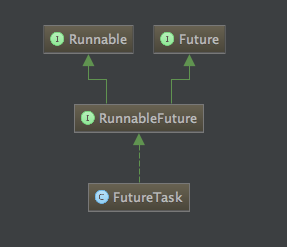FutureTask介绍
FutureTask是一种可以取消的异步的计算任务。它的计算是通过Callable实现的,可以把它理解为是可以返回结果的Runnable。
使用FutureTask的优势有:
- 可以获取线程执行后的返回结果;
- 提供了超时控制功能。
它实现了Runnable接口和Future接口:

什么是异步计算呢?也就是说,在让该任务执行时,不需要一直等待其运行结束返回结果,而是可以先去处理其他的事情,然后再获取返回结果。例如你想下载一个很大的文件,这时很耗时的操作,没必要一直等待着文件下载完,你可以先去吃个饭,然后再回来看下文件是否下载完成,如果下载完成就可以使用了,否则还需要继续等待。
FutureTask的实现
FutureTask的状态
FutureTask内部有这样几种状态:
|
|
看名字应该很好理解了,当创建一个FutureTask对象是,初始的状态是NEW,在运行时状态会转换,有4中状态的转换过程:
- NEW -> COMPLETING -> NORMAL:正常执行并返回;
- NEW -> COMPLETING -> EXCEPTIONAL:执行过程中出现了异常;
- NEW -> CANCELLED;执行前被取消;
- NEW -> INTERRUPTING -> INTERRUPTED:取消时被中断。
使用FutureTask
下面看一下具体的使用过程:
|
|
FutureTask内部结构
|
|
这里的waiters理解为一个stack,因为在调用get方法时任务可能还没有执行完,这时需要将调用get方法的线程放入waiters中。
最重要的两个get方法,用于获取返回结果,第二种提供了超时控制功能。
FutureTask构造方法
FutureTask有两个构造方法:
|
|
第二种构造方法传入一个Runnable对象和一个返回值对象,因为Runnable是没有返回值的,所以要通过result参数在执行完之后返回结果。
run方法
FutureTask实现了Runnable接口,所以需要实现run方法,代码如下:
|
|
总结一下run方法的执行过程
- 只有state为NEW的时候才执行任务;
- 执行前要设置runner为当前线程,使用CAS来设置是为了防止竞争;
- 如果任务执行成功,任务状态从NEW转换为COMPLETING,如果执行正常,设置最终状态为NORMAL;如果执行中出现了异常,设置最终状态为EXCEPTIONAL;
- 唤醒并删除Treiber Stack中的所有节点;
- 如果调用了cancel(true)方法进行了中断,要确保在run方法执行结束前的状态是INTERRUPTED。
这里涉及到3个比较重要的方法:setException,set和handlePossibleCancellationInterrupt。
setException方法
|
|
如果在执行过程中(也就是调用call方法时)出现了异常,则要把状态先设置为COMPLETING,如果成功,设置outcome = t,outcome对象是Object类型的,用来保存异常或者返回结果对象,也就是说,在正常的执行过程中(没有异常,没有调用cancel方法),outcome保存着返回结果对象,会被返回,如果出现了异常或者中断,则不会返回并抛出异常,这个在介绍report方法时会讲到。
接着设置状态为EXCEPTIONAL,这也是最终的状态。
finishCompletion方法稍后再分析。
set方法
|
|
很简单,与setException类似,只不过这里的outcome是返回结果对象,状态先设置为COMPLETING,然后再设置为MORMAL。
handlePossibleCancellationInterrupt方法
|
|
handlePossibleCancellationInterrupt方法要确保cancel(true)产生的中断发生在run或runAndReset方法执行的过程中。这里会循环的调用Thread.yield()来确保状态在cancel方法中被设置为INTERRUPTED。
这里不能够清除中断标记,因为不能确定中断一定来自于cancel方法。
finishCompletion方法
|
|
在调用get方法时,如果任务还没有执行结束,则会阻塞调用的线程,然后把调用的线程放入waiters中,这时,如果任务执行完毕,也就是调用了finishCompletion方法,waiters会依次出栈并逐个唤醒对应的线程。
由此可以想到,WaitNode一定是在get方法中被添加到栈中的,下面来看下get方法的实现。
get方法
|
|
这两个方法类似,首先判断状态,如果s <= COMPLETING,说明任务已经执行完毕,但set方法或setException方法还未执行结束(还未设置状态为NORMAL或EXCEPTIONAL),这时需要将当前线程添加到waiters中并阻塞。
第二种get提供了超时功能,如果在规定时间内任务还未执行完毕或者状态还是COMPLETING,则获取结果超时,抛出TimeoutException。而第一种get会一直阻塞直到state > COMPLETING。
awaitDone方法
awaitDone方法的工作是根据状态来判断是否能够返回结果,如果任务还未执行完毕,要添加到waiters中并阻塞,否则返回状态。代码如下:
|
|
removeWaiter方法
|
|
cancel方法
cancel方法用于取消任务,这里可能有两种情况,一种是任务已经执行了,另一种是还未执行,代码如下:
|
|
第一个if判断可能有些不好理解,其实等价于如下代码:
|
|
如果状态不是NEW,或者设置状态为INTERRUPTING或CANCELLED失败,则取消失败,返回false。
简单来说有一下两种情况:
- 如果当前任务还没有执行,那么state == NEW,那么会尝试设置状态,如果设置状态失败会返回false,表示取消失败;
- 如果当前任务已经被执行了,那么state > NEW,也就是!state == NEW为true,直接返回false。
也就是说,如果任务一旦开始执行了(state != NEW),那么就不能被取消。
如果mayInterruptIfRunning为true,要中断当前执行任务的线程。
report方法
get方法在调用awaitDone方法后,会调用report方法进行返回:
|
|
很简单,可以看到有3中执行情况:
- 如果
s == NORMAL为true,说明是正常执行结束,那么根据上述的分析,在正常执行结束时outcome存放的是返回结果,把outcome返回; - 如果
s >= CANCELLED为true,说明是被取消了,抛出CancellationException; - 如果
s < CANCELLED,那么状态只能是是EXCEPTIONAL,表示在执行过程中出现了异常,抛出ExecutionException。
runAndReset方法
该方法和run方法类似,区别在于这个方法不会设置任务的执行结果值,所以在正常执行时,不会修改state,除非发生了异常或者中断,最后返回是否正确的执行并复位:
|
|
总结
本文分析了FutureTask的执行过程和获取返回值的过程,要注意以下几个地方:
- FutureTask是线程安全的,在多线程下任务也只会被执行一次;
- 注意在执行时各种状态的切换;
- get方法调用时,如果任务没有结束,要阻塞当前线程,法阻塞的线程会保存在一个Treiber Stack中;
- get方法超时功能如果超时未获取成功,会抛出TimeoutException;
- 注意在取消时的线程中断,在run方法中一定要保证结束时的状态是INTERRUPTED,否则在cancel方法中可能没有执行interrupt,造成中断的泄露。